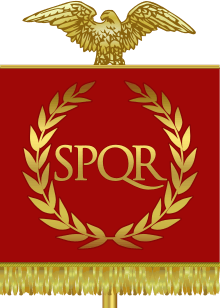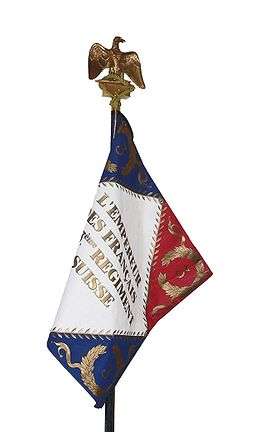French Imperial Eagle
The French Imperial Eagle (Aigle de drapeau, lit. "flag eagle") refers to the figure of an eagle on a staff carried into battle as a standard by the Grande Armée of Napoleon I during the Napoleonic Wars.
Although they were presented with regimental colours, the regiments of Napoleon I tended to carry at their head the imperial eagle.
History

On 5 December 1804, three days after his coronation. Napoleon distributed "aigles" based on the Roman aquila of the legions of Rome. The standards represented the regiments raised by the various departments of France, and were intended to institute feelings of pride and loyalty among the troops who would be the backbone of Napoleon's new regime. Napoleon gave an emotional speech in which he insisted that troops should defend the standards with their lives. This event was depicted in The Distribution of the Eagle Standards, a painting by Jacques-Louis David.
The original design was sculpted by Antoine-Denis Chaudet and then copies were cast in the workshop of Pierre-Philippe Thomire, with the first eagles presented on 5 December 1804.[1] It was a bronze sculpture of an eagle on a plinth, with one claw resting on "Jupiter's spindle".[1] weighing 1.85 kg (4 lb), mounted on top of the blue regimental flagpole. They were made from six separately cast pieces designed along Roman lines and, when assembled, measured 310 mm (12 in) in height and 255 mm (10 in) in width.[1] On the base would be the regiment's number or, in the case of the guard, Garde Impériale. The eagle bore the same significance to French Imperial regiments as the colours did to British regiments - to lose the eagle would bring shame to the regiment, who had pledged to defend it to the death. Upon Napoleon's fall, the restored monarchy of Louis XVIII of France ordered all eagles to be destroyed and only a very small number were not. When the former emperor returned to power in 1815 (known as the Hundred Days) he immediately had more eagles produced, although the quality did not match the originals. The workmanship was of a lesser quality and the main distinguishing changes had the new models with closed beaks and they were set in a more crouched posture.
| Origins, variants and surviving instance | ||||||||
|---|---|---|---|---|---|---|---|---|
|
Captured eagles
The first capture of an eagle was most likely during the Battle of Austerlitz in 1805 when the Russian cavalry of the guard under Grand Duke Constantin overran the French 4th Line Infantry Regiment, taking their flag. Although Napoleon won the battle, the Russians were able to retreat in good order and the eagle was not recovered, much to the Emperor's regret.
In 1807 at Heilsberg the 55th Line was overthrown by Prussian cavalry and Russian infantry. An eagle was lost and several officers including a colonel were killed. The eagle was captured by NCO Anton Antonov of the Pernov Musketeers. Prussian historians dispute this, claiming that the Prittwitz Hussars captured the eagle. The names of the Prussian soldiers who captured the eagle are unknown and there is little evidence to back up this claim. German artist Knotel painted a picture showing this moment.
In 1807, near Eylau, the 18th Line lost its flag and eagle to the Russian St. Petersburg Dragoons. In 1812 at Krasne, the 18th Line (the "Brave") again lost its eagle and was “virtually destroyed” by the Russian Lifeguard Uhlans.
In 1808, at the Battle of Bailén, the French corps led by General Dupont surrendered after being defeated by a Spanish army led by generals Castaños and Reding; this was the first surrender of an imperial field army. As part of the capitulation terms, the French gave up their flags and banners, including three eagles. These eagles were kept in the Cathedral of Seville until they were recovered by the French in 1810 and sent back to Paris.[2]
The first French eagle to be captured by the British was taken by the 87th (Royal Irish Fusiliers) Regiment of Foot from the French 8th Line at the Battle of Barrosa on 5 March 1811. The first British soldier to touch the battle standard was a young officer, Ensign Edward Keogh, although as his hand grasped it, he was immediately shot through the heart and killed. He was followed by Sergeant Patrick Masterson, who grabbed the eagle from the French ensign who carried it, reputedly with the cry "By Jaysus, boys, I have the cuckoo".
The 87th was highly honoured for their success, being granted the honour of carrying the eagle as a motif on their regimental colours and through being granted the royal title "87th (Prince of Wales' Own) Irish Regiment".
The eagle was taken back to England and put on display in the Royal Hospital, Chelsea. It was around 10 inches tall, set on a plinth marked with the numeral 8. It was made of silver, but gilded, which led many to think it was solid gold. In fact, the only golden part of the eagle was a laurel wreath which hung around its neck. This wreath was an honour conferred upon the 8th Regiment by Napoleon himself, and was not common to all eagles at the time. The gold leaves were presented to a number of regiments that were present at the Battle of Austerlitz by the city of Paris. The eagle's right claw was raised. Beneath it should have been a thunderbolt but, on the 87th's trophy, it was missing. It is believed to have been dislodged during its capture.
Several years later, the eagle was stolen from the Royal Hospital. It was broken from its staff and smuggled away to an unknown fate. Many rumours abounded, the strongest being that it had been repatriated by a Frenchman. More likely it was melted down and sold. The original staff is still held in the Royal Irish Fusiliers museum in Armagh, Northern Ireland.
The British took two eagles at the Battle of Salamanca in July 1812. Ensign John Pratt of the Light Company of the 30th Foot (later 1st Battalion, East Lancashire Regiment) captured the eagle of 22nd Regiment de Ligne (displayed today in the Museum of The Duke of Lancaster's Regiment, Fulwood Barracks in Preston, Lancashire), while the 2nd Battalion of the 44th Foot took the eagle of the French 62nd Line.
Following the surrender of the French at the capture of Madrid on 14 August 1812, two eagles were found belonging to the 13e Régiment de Dragons and the 51e Régiment d'Infanterie de Ligne.[3]
Two of the newer French regimental eagles were captured during the Battle of Waterloo in 1815. The French I Corps under the command of Comte d'Erlon was charged by the British heavy cavalry, commanded by the Earl of Uxbridge; the Royal Dragoons captured the eagle of the 105the Line (now held at the National Army Museum, Chelsea) and the Scots Greys captured the eagle of the 45th Line.
Before the Duke of Wellington died in 1852, he had asked that all his battle trophies be carried at his funeral. As the eagle of the 87th was not available, it was decided to make a replica. The mould was made by Garrard's and was designed from a sketch of the original drawn by an officer of the 87th at the time of Barrosa. All contemporary eagles of the Royal Irish Fusiliers, Royal Irish Rangers and Royal Irish Regiment originate from this mould.
The capture of an eagle was celebrated through the addition of the eagle as a symbol or accoutrement to a regiment's colour or uniform. The Blues and Royals (Royal Horse Guards and 1st Dragoons) (descended from the 1st Royal Dragoons) and the Royal Anglian Regiment (descended from the 44th Foot) both wear the eagle as an arm badge,[4][5] while the cap badge of the Royal Scots Dragoon Guards (Carabiniers and Greys) (descended from the Royal Scots Greys) is an eagle.[6] The Royal Irish Regiment wear the eagle of the 8th on the back pouch of the officers' black cross belt.[7]
References
- 1 2 3 Wise, Terence (2012). Flags of the Napoleonic Wars (1): Colours, Standards and Guidons of France and her Allies. Osprey Publishing. pp. 4–6. ISBN 9781780966243.
- ↑ http://www.napoleon-series.org/military/battles/Bailen/c_bailentrophies1.html (in Spanish)
- ↑ Porter, Maj Gen Whitworth (1889). History of the Corps of Royal Engineers Vol I. Chatham: The Institution of Royal Engineers.
- ↑ "Orders of Dress for Officers of the Armoured Regiment". Household Cavalry Museum. Retrieved 21 October 2013.
- ↑ "Symbols and Badges". Royal Anglian Regiment Museum. Royal Anglian Regiment. Retrieved 21 October 2013.
- ↑ "Royal Scots Dragoon Guards: Regimental History and Traditions". Ministry of Defence. Retrieved 21 October 2013.
- ↑ "Royal Irish Regiment: History of the Regiment" (PDF). British Army Website. Retrieved 21 October 2013.
External links
| Wikimedia Commons has media related to French Imperial Eagles. |
- http://napoleonistyka.atspace.com/French_infantry.html">French Napoleonic Infantry 1800-1815
- http://qlrmuseum.co.uk



